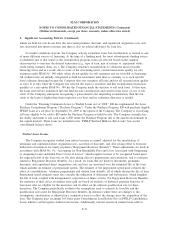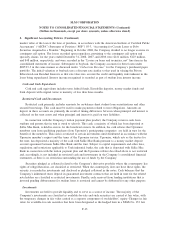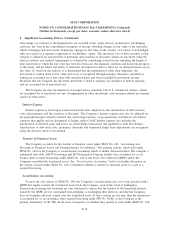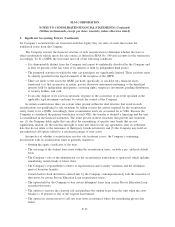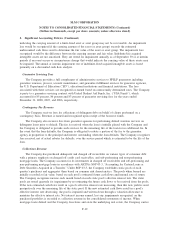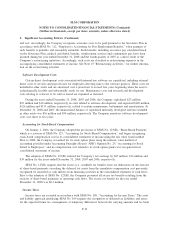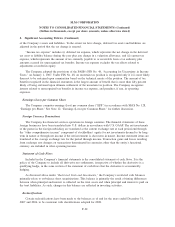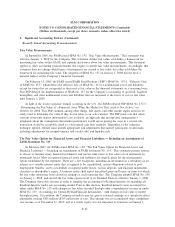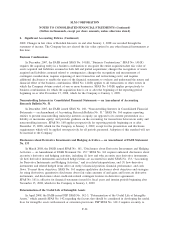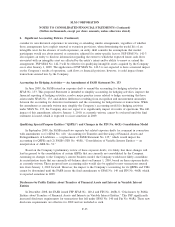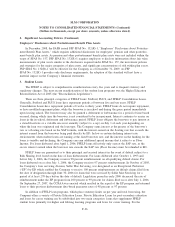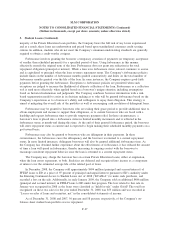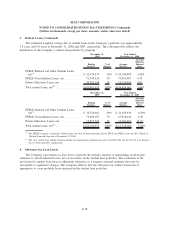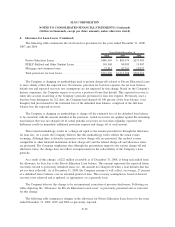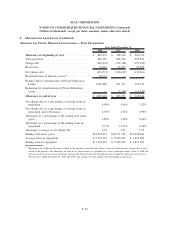Sallie Mae 2008 Annual Report Download - page 141
Download and view the complete annual report
Please find page 141 of the 2008 Sallie Mae annual report below. You can navigate through the pages in the report by either clicking on the pages listed below, or by using the keyword search tool below to find specific information within the annual report.2. Significant Accounting Policies (Continued)
and vest. Accordingly, the Company recognizes severance costs to be paid pursuant to the Severance Plan in
accordance with SFAS No. 112, “Employer’s Accounting for Post Employment Benefits,” when payment of
such benefits is probable and reasonably estimable. Such benefits, including severance pay calculated based
on the Severance Plan, medical and dental benefits, outplacement services and continuation pay, have been
incurred during the year ended December 31, 2008 and the fourth quarter of 2007 as a direct result of the
Company’s restructuring initiatives. Accordingly, such costs are classified as restructuring expenses in the
accompanying consolidated statements of income. See Note 15 “Restructuring Activities,” for further informa-
tion on the restructuring activities.
Software Development Costs
Certain direct development costs associated with internal-use software are capitalized, including external
direct costs of services and payroll costs for employees devoting time to the software projects. These costs are
included in other assets and are amortized over a period not to exceed five years beginning when the asset is
technologically feasible and substantially ready for use. Maintenance costs and research and development
costs relating to software to be sold or leased are expensed as incurred.
During the years ended December 31, 2008, 2007 and 2006, the Company capitalized $23 million,
$19 million and $16 million, respectively, in costs related to software development, and expensed $120 million,
$126 million and $131 million, respectively, related to routine maintenance, betterments and amortization. At
December 31, 2008 and 2007, the unamortized balance of capitalized internally developed software included
in other assets was $56 million and $54 million, respectively. The Company amortizes software development
costs over three to five years.
Accounting for Stock-Based Compensation
On January 1, 2006, the Company adopted the provisions of SFAS No. 123(R), “Share-Based Payment,”
which is a revision of SFAS No. 123, “Accounting for Stock-Based Compensation,” and began recognizing
stock-based compensation cost in its consolidated statements of income using the fair value based method.
Prior to 2006, the Company accounted for its stock option plans using the intrinsic value method of
accounting provided under Accounting Principles Board (“APB”) Opinion No. 25, “Accounting for Stock
Issued to Employees,” and no compensation cost related to its stock option grants was recognized in its
consolidated statements of income.
The adoption of SFAS No. 123(R) reduced the Company’s net earnings by $47 million, $36 million and
$39 million for the years ended December 31, 2008, 2007 and 2006, respectively.
SFAS No. 123(R) requires that the excess (i.e., windfall) tax benefits from tax deductions on the exercise
of share-based payments exceeding the deferred tax assets from the cumulative compensation cost previously
recognized be classified as cash inflows from financing activities in the consolidated statement of cash flows.
Prior to the adoption of SFAS No. 123(R), the Company presented all excess tax benefits resulting from the
exercise of share-based payments as operating cash flows. The excess tax benefit for the year ended
December 31, 2008 was $0.3 million.
Income Taxes
Income taxes are recorded in accordance with SFAS No. 109, “Accounting for Income Taxes.” The asset
and liability approach underlying SFAS No. 109 requires the recognition of deferred tax liabilities and assets
for the expected future tax consequences of temporary differences between the carrying amounts and tax basis
F-21
SLM CORPORATION
NOTES TO CONSOLIDATED FINANCIAL STATEMENTS (Continued)
(Dollars in thousands, except per share amounts, unless otherwise stated)


